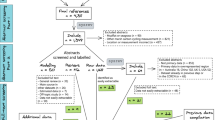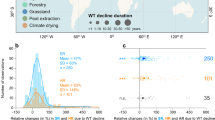Abstract
Global-scale variation in mangrove ecosystem properties has been explained using a conceptual framework linking geomorphological processes to distinct coastal environmental settings (CES) for nearly 50 years. However, these assumptions have not been empirically tested at the global scale. Here, we show that CES account for global variability in mangrove soil C:N:P stoichiometry and soil organic carbon (SOC) stocks. Using this ecogeomorphology framework, we developed a global model that captures variation in mangrove SOC stocks compatible with distinct CES. We show that mangrove SOC stocks have been underestimated by up to 50% (a difference of roughly 200 Mg ha−1) in carbonate settings and overestimated by up to 86% (around 400 Mg ha−1) in deltaic coastlines. Moreover, we provide information for 57 nations that currently lack SOC data, enabling these and other countries to develop or evaluate their blue carbon inventories.
This is a preview of subscription content, access via your institution
Access options
Access Nature and 54 other Nature Portfolio journals
Get Nature+, our best-value online-access subscription
$29.99 / 30 days
cancel any time
Subscribe to this journal
Receive 12 print issues and online access
$209.00 per year
only $17.42 per issue
Buy this article
- Purchase on Springer Link
- Instant access to full article PDF
Prices may be subject to local taxes which are calculated during checkout





Similar content being viewed by others
References
Boyd, R., Dalrymple, R. & Zaitlin, B. A. Classification of clastic coastal depositional environments. Sediment. Geol. 80, 139–150 (1992).
Dürr, H. H. et al. Worldwide typology of nearshore coastal systems: defining the estuarine filter of river inputs to the oceans. Estuaries Coasts 34, 441–458 (2011).
Thom, B. G. in Mangrove Ecosystems in Australia: Structure, Function and Management (ed. Clough, B. F.) 3–17 (Australian National Univ. Press, Canberra, 1982).
Woodroffe, C. in Coastal and Estuarine Studies—Tropical Mangrove Ecosystems Vol 41 (eds Robertson, A. I. & Alongi, D. M.) 7–41 (American Geophysical Union, Washington DC, 1992).
Wheaton, J. M., Gibbins, C., Wainwright, J., Larsen, L. & McElroy, B. Multiscale feedbacks in ecogeomorphology. Geomorphology 126, 265–268 (2011).
Twilley, R. R., Chen, R. & Hargis, T. Carbon sinks in mangroves and their implications to carbon budget of tropical coastal ecosystems. Water Air Soil Pollut. 64, 265–288 (1992).
Twilley, R. R. in Maximum Power: the Ideas and Applications of H. T. Odum (ed. Hall, C. A. S.) 43–62 (Univ. Press Colorado, Niwot, 1995).
Allison, S. D., Wallenstein, M. D. & Bradford, M. A. Soil-carbon response to warming dependent on microbial physiology. Nat. Geosci. 3, 336–340 (2010).
Janssens, I. A. et al. Reduction of forest soil respiration in response to nitrogen deposition. Nat. Geosci. 3, 315–322 (2010).
Diamond, J. M. & Case, T. J. Community Ecology (Harper & Row, New York, 1986).
Jardine, S. L. & Siikamäki, J. V. A global predictive model of carbon in mangrove soils. Environ. Res. Lett. 9, 104013 (2014).
Atwood, T. B. et al. Global patterns in mangrove soil carbon stocks and losses. Nat. Clim. Change 7, 523–528 (2017).
Lovelock, C. E., Feller, I. C., Ball, M. C., Ellis, J. & Sorrell, B. Testing the growth rate vs. geochemical hypothesis for latitudinal variation in plant nutrients. Ecol. Lett. 10, 1154–1163 (2007).
Harrison, J. A. et al. Dissolved inorganic phosphorus export to the coastal zone: results from a spatially explicit, global model. Glob. Biogeochem. Cycles 19, GB4S03 (2005).
Syvitski, J. P. M., Vörösmarty, C. J., Kettner, A. J. & Green, P. Impact of humans on the flux of terrestrial sediment to the global coastal ocean. Science 308, 376–380 (2005).
Henry, K. M. & Twilley, R. R. Soil development in a coastal Louisiana wetland during a climate-induced vegetation shift from salt marsh to mangrove. J. Coast. Res. 29, 1273–1283 (2013).
Xu, X., Thornton, P. E. & Post, W. M. A global analysis of soil microbial biomass carbon, nitrogen and phosphorus in terrestrial ecosystems. Glob. Ecol. Biogeogr. 22, 737–749 (2013).
Grömping, U. R package relaimpo: relative importance for linear regression. J. Stat. Softw. 17, 139–147 (2006).
Castañeda-Moya, E., Twilley, R. R. & Rivera-Monroy, V. H. Allocation of biomass and net primary productivity of mangrove forests along environmental gradients in the Florida Coastal Everglades, USA. Forest Ecol. Manag. 307, 226–241 (2013).
Lovelock, C. E. et al. The vulnerability of Indo-Pacific mangrove forests to sea-level rise. Nature 526, 559–563 (2015).
Woodroffe, C. D. et al. Mangrove sedimentation and response to relative sea-level rise. Ann. Rev. Mar. Sci. 8, 243–266 (2016).
Ouyang, X., Lee, S. Y. & Connolly, R. M. The role of root decomposition in global mangrove and saltmarsh carbon budgets. Earth Sci. Rev. 166, 53–63 (2017).
Pregitzer, K. S., King, J. S., Burton, A. J. & Brown, S. E. Responses of tree fine roots to temperature. New Phytol. 147, 105–115 (2000).
Feher, L. C. et al. Linear and nonlinear effects of temperature and precipitation on ecosystem properties in tidal saline wetlands. Ecosphere 8, e01956 (2017).
Gabler, C. A. et al. Macroclimatic change expected to transform coastal wetland ecosystems this century. Nat. Clim. Change 7, 142–147 (2017).
Rovai, A. S. et al. Scaling mangrove aboveground biomass from site-level to continental-scale. Glob. Ecol. Biogeogr. 25, 286–298 (2016).
Hutchison, J. et al. Building an expert-judgment-based model of mangrove fisheries. Am. Fish. Soc. Symp. 83, 17–42 (2015).
Giri, C. et al. Status and distribution of mangrove forests of the world using earth observation satellite data. Glob. Ecol. Biogeogr. 20, 154–159 (2011).
Woodroffe, C. D. Coasts: Form, Process and Evolution (Cambridge Univ. Press, Cambridge, 2002).
Koch, M. S., Benz, R. E. & Rudnick, D. T. Solid-phase phosphorus pools in highly organic carbonate sediments of northeastern Florida Bay. Estuar. Coast. Shelf Sci. 52, 279–291 (2001).
Twilley, R. R., Castañeda-Moya, E., Rivera-Monroy, V. H. & Rovai, A. S. in Mangrove Ecosystems: A Global Biogeographic Perspective (eds. Rivera-Monroy, V. H., Lee, S. Y., Kristensen, E. & Twilley, R. R.) Ch. 5 (Springer International Publishing, Zurich, 2017).
Howard, J., Hoyt, S., Isensee, K., Pidgeon, E. & Telszewski, M. Coastal Blue Carbon: Methods for Assessing Carbon Stocks and Emissions Factors in Mangroves, Tidal Salt Marshes, and Seagrass Meadows (Conservation International, Intergovernmental Oceanographic Commission of UNESCO & International Union for Conservation of Nature, 2014).
Harris, D., Horwáth, W. R. & van Kessel, C. Acid fumigation of soils to remove carbonates prior to total organic carbon or carbon-13 isotopic analysis. Soil Sci. Soc. Am. J. 65, 1853–1856 (2001).
Aspila, K. I., Agemian, H. & Chau, A. S. Y. A semi-automated method for the determination of inorganic, organic and total phosphate in sediments. Analyst 101, 187–197 (1976).
Hijmans, R. J., Cameron, S. E., Parra, J. L., Jones, P. G. & Jarvis, A. Very high resolution interpolated climate surfaces for global land areas. Int. J. Climatol. 25, 1965–1978 (2005).
Osland, M. J. et al. Beyond just sea-level rise: considering macroclimatic drivers within coastal wetland vulnerability assessments to climate change. Glob. Change Biol. 22, 1–11 (2016).
Easterling, D. R. et al. Climate extremes: observations, modeling, and impacts. Science 289, 2068–2074 (2000).
Osland, M. J. et al. Mangrove expansion and contraction at a poleward range limit: climate extremes and land–ocean temperature gradients. Ecology 98, 125–137 (2017).
Osland, M. J. et al. Climatic controls on the global distribution, abundance, and species richness of mangrove forests. Ecol. Monogr. 87, 341–359 (2017).
Mu, Q., Zhao, M. & Running, S. W. Improvements to a MODIS global terrestrial evapotranspiration algorithm. Remote Sens. Environ. 115, 1781–1800 (2011).
Carrère, L., Lyard, F., Cancet, M., Guillot, A. & Roblou, L. FES 2012: a new global tidal model taking advantage of nearly 20 years of altimetry measurements. In Proc. 20 Years of Progress in Radar Altimetry Symp. (Avisno & cnes, 2012).
Fekete, B. M., Vörösmarty, C. J. & Grabs, W. High-resolution fields of global runoff combining observed river discharge and simulated water balances. Glob. Biogeochem. Cycles 16, 15-1–15-10 (2002).
Graham, M. H. & Edwards, M. S. Statistical significance versus fit: estimating the importance of individual factors in ecological analysis of variance. Oikos 93, 505–513 (2001).
Scott, A. J. & Knott, M. A cluster analysis method for grouping means in the analysis of variance. Biometrics 30, 507–512 (1974).
Anderson, M. J., Ellingsen, K. E. & McArdle, B. H. Multivariate dispersion as a measure of beta diversity. Ecol. Lett. 9, 683–693 (2006).
Anderson, M. J. A new method for non-parametric multivariate analysis of variance. Austral Ecol. 26, 32–46 (2001).
Saintilan, N., Rogers, K., Mazumber, D. & Woodroffe, C. Allochthonous and autochthonous contributions to carbon accumulation and carbon store in southeastern Australian coastal wetlands. Estuar. Coast. Shelf Sci. 128, 84–92 (2013).
Suárez-Abelenda, M. et al. The effect of nutrient-rich effluents from shrimp farming on mangrove soil carbon storage and geochemistry under semi-arid climate conditions in northern Brazil. Geoderma 213, 551–559 (2014).
Hamilton, S. E. & Casey, D. Creation of a high spatio-temporal resolution global database of continuous mangrove forest cover for the 21st century (CGMFC-21). Glob. Ecol. Biogeogr. 25, 729–738 (2016).
Acknowledgements
The Brazilian foundations CAPES and CNPq, Louisiana Sea Grant College and NSF Coastal SEES programme (EAR-1427389) funded this work. The CAPES/CNPq Science without Borders and Post-doctoral Senior programmes provided international fellowships for A.S.R. (BEX1930/13-3), P.R.P. (18379/12-5) and A.L.F (209666/13-7). We are thankful to the Florida Coastal Everglades Long-Term Ecological Research programme (permit EVER-2013-SCI-0058), Rookery Bay National Estuarine Research Reserve (especially K. Cunniff) and J.N. “Ding” Darling National Wildlife Refuge (permit FWS 14042) for facilitating the collection of samples. We also thank S. L. Jardine for kindly providing a high-resolution mangrove soil carbon density grid to serve as a reference in our modelling analyses. We are extremely indebted to T. Blanchard (Department of Oceanography and Coastal Sciences, LSU) and P. Leandro (CATIE) for support with laboratory analyses, as well as to W. Weis and R. Menghini for assistance during fieldwork and A. Christensen and A. McCall for assistance with manipulation of the raster files.
Author information
Authors and Affiliations
Contributions
A.S.R. conceived the study, performed the statistical analyses and wrote the manuscript draft. P.R. and A.S.R. performed the modelling analyses. R.R.T., P.R.P., E.C.-M. and P.R. contributed to development of the work in general and helped to write the final version of the paper. M.C.-J. collected and analysed soil samples from El Salvador, Panama and some sites in Costa Rica. P.R.P., E.C.-M., M.M.-V., P.A.H., J.C.S. and A.L.F. contributed to field sampling and laboratory analyses.
Corresponding author
Ethics declarations
Competing financial interests
The authors declare no competing interests.
Additional information
Publisher’s note: Springer Nature remains neutral with regard to jurisdictional claims in published maps and institutional affiliations.
Supplementary information
Supplementary Information
Supplementary Note 1, Supplementary Figures 1–6, Supplementary Tables 2–5, Supplementary References
Supplementary Table 1
Contains the global mangrove soil organic carbon density dataset used in the modelling analysis. File format: Excel, file size: 35KB
Rights and permissions
About this article
Cite this article
Rovai, A.S., Twilley, R.R., Castañeda-Moya, E. et al. Global controls on carbon storage in mangrove soils. Nature Clim Change 8, 534–538 (2018). https://doi.org/10.1038/s41558-018-0162-5
Received:
Accepted:
Published:
Issue Date:
DOI: https://doi.org/10.1038/s41558-018-0162-5
This article is cited by
-
The inclusion of Amazon mangroves in Brazil’s REDD+ program
Nature Communications (2024)
-
Determining Environmental Drivers of Fine-Scale Variability in Blue Carbon Soil Stocks
Estuaries and Coasts (2024)
-
Vegetated coastal ecosystems in the Southwestern Atlantic Ocean are an unexploited opportunity for climate change mitigation
Communications Earth & Environment (2023)
-
Geomorphic and ecological constraints on the coastal carbon sink
Nature Reviews Earth & Environment (2023)
-
A Spatial Model Comparing Above- and Belowground Blue Carbon Stocks in Southwest Florida Mangroves and Salt Marshes
Estuaries and Coasts (2023)



